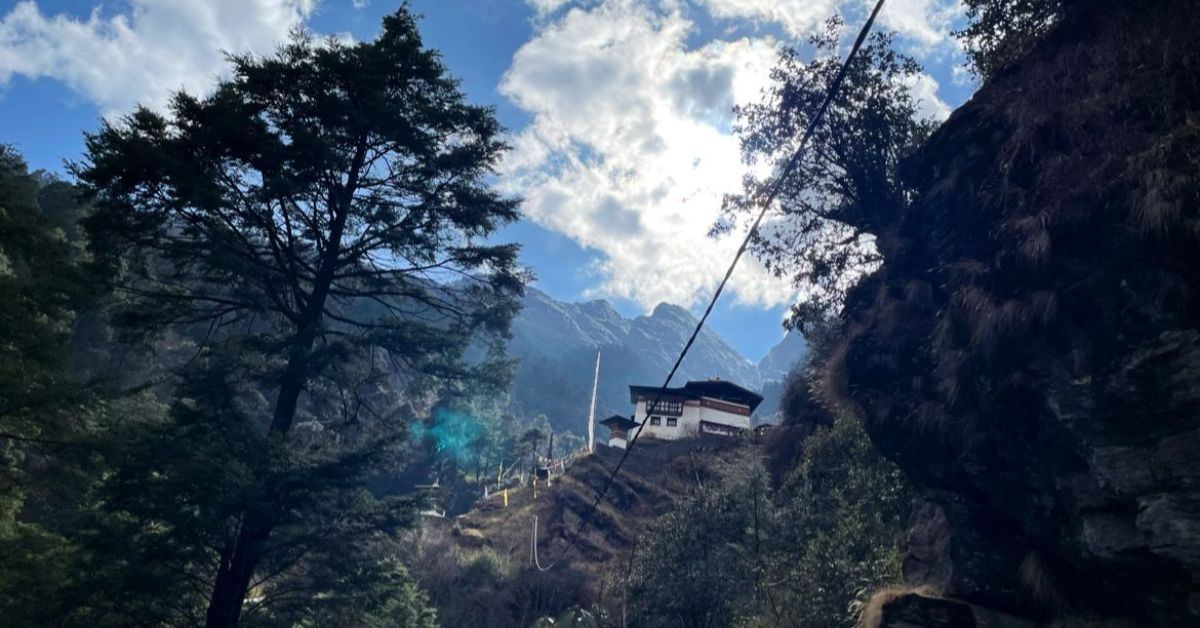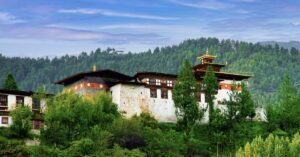Chumphu Ney is a meditation place of Guru Rinpoche. It was originally known as Chumophug, “cave of holy water.” The Chumphu Nye was discovered by His Holiness the 9th Je Khenpo of Bhutan, Shakya Rinchen.
Chumphu Nye is located in the northern part of Dopshari Gewog of Paro Dzongkhag, at an altitude of 3078 meters (10170 ft) above sea level. The sacred relic of Chumphu Lhakhang is the famous floating statue of Dorji Phagmo defying gravity. It was discovered by Terton Drukdra Dorji from the lake above the Monastery.
How to Reach Chumphu Ney
The Chumphu Nye is located in the northern part of Dopshari Gewog of Paro Dzongkhag. Drive one and a half hours from Paro town. After parking your car at the last stop, Chumphu Goenpa Hike is a 4-hour hike up and a 3-hour hike back to the car parking. The spiritual hike is usually a day trip, during which people pack their lunch and have it at the parking after returning from Chumphu Ney. There are no night halt facilities at the monastery. However, some hikers spend a night camping at the sacred site.
Chumphu Ney Hike
Chumphu Ney Hike is one of the best pilgrimage hikes in Bhutan for those who love connecting with pristine nature. The Hike is around 9 km. The Chumphu Nye hike starts on a gentle slope as one crosses the entry gate (Zigo), naturally formed by two boulders, and has a sharp ascent of 826 meters at the end of the hike to reach the monastery at the top.
The climb begins at the bridge and passes through several sacred caves, rocks, and waterfalls associated with Guru Rinpoche, Dakinis, and Saints. The amazing sights along the way as one hikes up include the gateway to heaven, Guru Rinpoche’s throne, an imprint of Guru Rinpoche, the Guru’s ceremonial robe on a rock, a stone vase filled with the holy water of long life, and impressions of Dakinis.
The trail is longer than hiking up Tiger’s Nest, but it is not as physically exhausting. It is enjoyable and follows a lovely river through a charming forest till you come to a Chorten. The hike is on flat land with little gradient until the last part of the trail at a bridge at the base of the hill. However, the final hundred meters incline up to the monastery is steep.
Also Read: Paro Taktsang Tiger’s Nest Hike
Sacred Relics to See at Chumphu Goenpa
- The floating statue of Dorji Phagmo (Vajravarahi) defying gravity;
- Numerous caves where Guru Rimpoche and his consorts, Dakinis, and legendary scholars have meditated;
- The gate to heaven;
- Guru Rinpoche’s throne;
- Imprints of Guru Rinpoche;
- Ceremonial robe of the Guru Rinpoche on a rock;
- A stone vase containing the elixir of Immortality;
- Imprints of Dakinis/saints;
- Rocky cliffs that contain secret jewels to be revealed in degenerated times.
Also Read: Guru Rinpoche in Bhutan: His Visits to Bhutan and Sacred Sites
Historical Significance of Chumphu Nye
According to history, Guru Rinpoche returned to Chumophug and meditated for two months following his historic visit to Paro Taktsang Monastery on the back of a Tigress. The initial name of Chumphu Nye was Chumophug, which means “cave of holy water.”
Guru Rinpoche had described the sacred site at Chumophu: ‘The sound of the churning water; rings the sound of dharma; mother dakini, the holder of awareness; is endowed with the dual aspects of siddhi; in the cave akin to the source of dharma; the main treasure is the meteoric dagger of the pure realm’.
The Chumphu Nye was discovered by His Holiness the 9th Je Khenpo of Bhutan, Shakya Rinchen. Later, Terton Drukdra Dorji visited Chumphu Lhakhang and discovered Dorji Phagmo’s statue from the lake above the Monastery.
Chumphu Nye is also considered the second Tsari. The first tsari is in Tibet, known as Tsari Rongkor. However, it was prophesied that Tsari Rongkor would decline steadily over time, and Chumphu Nye would then become the main Tsari.
Description of Chumophu Ney
Chumophu has two sacred sites: the upper and lower sites; the lower site, where there are remains of an old temple, is believed to have been blessed by Guru Padmasambhava in the 8th century.
There are holy waterfalls and sacred caves where Guru Rinpoche and his consorts have meditated. Many legendary scholars also meditated there. The longevity water (Tshechhu) oozing out of a rock is the most sacred water of the Chumphu Ney. The Tshechhu is believed to heal various diseases and give a long life. Waterfalls are said to be the bathing place of Guru Rinpoche, and big rock openings are said to be the opening gates to Heaven.
A 20-minute hike uphill from the temple leads to a holy waterfall. This is considered a lake from which the statue of Dorji Phagmo was discovered. Taking bamboo pieces (tsari nguma) from the vicinity of the waterfall, which are used to fashion amulets and talismans, is a common practice among devotees who visit Chumphu Ney.
Chumphu Lhakhang
The temple is perched atop a hilltop surrounded by three crown-shaped mountains. His Holiness the Ninth Je Khenpo Shakya Rinchen built the present Chumphu Lhakang and named it Tsari Nyipa. The Chumphu monastery, built in the middle, at the heart of the body, is depicted in an aerial view of the region as an imaginary figure of a female wearing the crown. However, the present temple is allegedly founded by Choejey Pema Jungney from Shara Drango village.
The main statue of Chumphu Lhakhang is a 5-foot-tall floating statue of Dorji Phagmo (Vajravarahi) defying gravity. Believe it or not, one leg is crossed at the knees, and the other is standing but does not touch the ground. The Lama at the temple proves this by moving money back and forth under the feet of the floating statue.
According to history, the Dorji Phagmo statue was discovered from the lake above the Monastery by Terton Drukdra Dorji. The statue was around a foot tall when it was discovered from the sacred Lake. But with prophecy, His Holiness Je Shakya Rinchen planned to build a statue the same size as Tsari Nye by covering the foot-tall statue from the outside. However, the statue has grown to its present size by itself. Another legend has it that the Goddess Dorji Phamo flew from Tibet and stayed on as a statue there.
It is believed that whoever visits this temple, built on the crest of the crescent-shaped hill, is instantly liberated from the cycle of suffering owing to the site’s sacredness. Guru had even mentioned, ‘In the crescent-shaped cliff, there are concealed treasures on dharma teachings, on the face of the cliff, there is a foot impression of His Master (Guru Rinpoche)’.
Best Time to Visit Chumphu Ney
In Bhutan, the spring season, which runs from March to the end of May, and the autumn season, which runs from the end of September to the middle of November, are the best times to go hiking to your favorite places. Therefore, the best time to visit Chumphu Nye is the spring and autumn. You can visit major pilgrimage sites in Paro with the Bhutan Pilgrimage Package.
Frequently Asked Questions
Where is Chumphu Nye Located?
Chumphu Nye is a meditation place of Guru Rinpoche located in the northern part of Doteng Gewog under Paro Dzongkhag at an altitude of 3078 meters above sea level.
Who discovered Chumphu Nye?
Chumphu Nye was discovered by His Holiness Shakya Rinchen, the 9th Je Khenpo of Bhutan.
What is the meaning of Chumphu nye?
The initial name of Chumphu Nye was Chumophug, which means “cave of holy water.” Chumophu Nye also translates to “Sacred Female Water Mountain”.
Why is Chumphu Nye important?
Chumphu Nye is an important pilgrimage site due to its historical connections with Guru Rinpoche, its status as the second Tsari, the presence of a floating statue of Dorji Phagmo, and the many sacred relics.
What is the floating statue in Bhutan?
The floating statue in Bhutan is a statue of Dorji Phagmo in the Chumphu Nye Monastery in Paro. This statue is believed to be an incarnation of Dolma (Tara), the divine consort of Chenrezig. The statue of Dorji Phagmo is known for defying gravity and is said to have been discovered at the lake above the monastery.
What do people do to preserve the Chumphu nye?
To preserve Chumphu Nye, the site is well-maintained and conserved by the local authorities and the community. Visitors have to respect the sacred sites and relics, including the floating statue of Dorji Phagmo, by not touching or disturbing them to maintain the spiritual significance and integrity of the site.
Enjoyed reading this blog?




